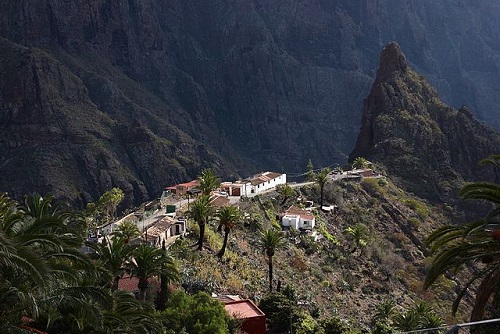
Two Provinces, Eight Islands and an Endless Array of Sights and Activities-What to See and Do in the Canary Islands
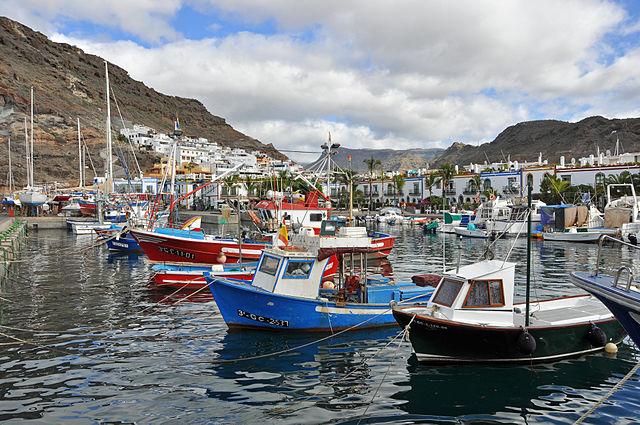
Tourism has been a major part of the Canary Islands’ economy since the 1960s. As many as 10 million tourists come to the islands for the perfect vacation weather, endless beaches and the diverse and beautiful landscapes. There is an endless lineup of attractions and activities to explore, which ensures that there is something here for everyone.
The Province of Las Palmas
Gran Canaria
The island of Gran Canaria has such a diversity of climates and landscapes, that it is often called the “Miniature Continent”. The most touristed area is the southern part of the island with its 37 miles of idyllic beaches and miles of sand dunes. But there are also pine forests, volcanic craters, imposing rock formations, villages, and, of course, one of the dual capital cities of the Canaries, Las Palmas de Gran Canaria.
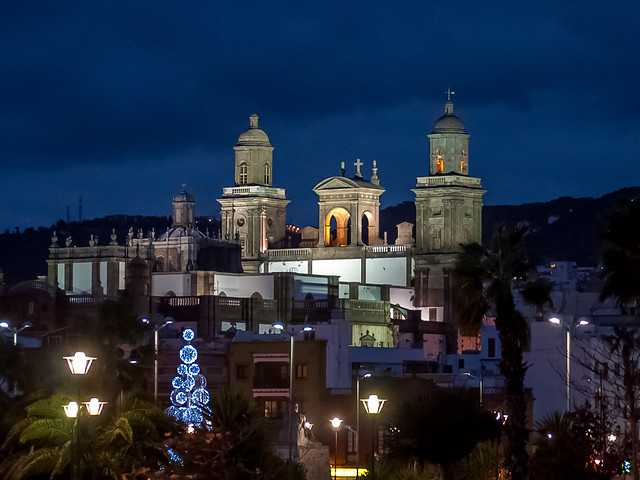

The colorful and lively city of Las Palmas has been claimed to have the best climate of any city in the world. Distinguished by its many parks, markets and plazas, the city also boasts one of the best urban beaches in Spain, Las Canteras. A popular cruise ship port, visitors can enjoy duty free shopping while exploring this beautiful city. Vegueta is the old part of town which dates back to the end of the 15th century. Expect to see old buildings of Gothic and Renaissance style, cobblestones, the magnificent Cathedral de Santa Ana, which took 350 years to build and the city’s oldest market, the Mercado de Vegueta.
Another of the city’s many neighborhoods is Triana, where you will find a pedestrian shopping area and perhaps the most beautiful plaza, the Plaza Cairasco. Las Palmas is occasionally referred to as ‘Little Havana’, likely due in part to the over six mile long Avenida Maritima, which runs along the waterfront from the fishing village of San Cristóbal, location of some of the best seafood restaurants to the Playa de las Alcaravaneras, another of the city’s golden sand beaches. Much like the Malecon of Havana, the seaside promenade bustles with activity as people jog, bike, ride or stroll along the picturesque Avenida.
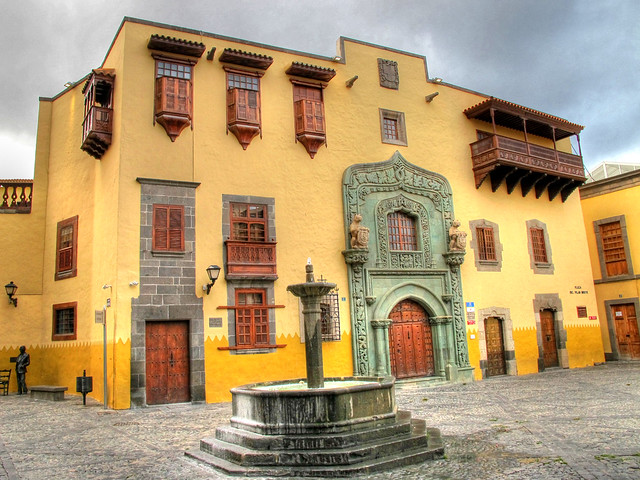
The Casa de Colon is the house where Christopher Columbus stayed while preparing to cross the the Atlantic en route to the new world. It is a museum which displays several of his belongings, journals and drawings. The Jardín Botánico Viera y Clavijo, Las Palmas’ botanical garden, contains everything from a succulent garden to a forest of tall trees. Virtually everything grows in this stunning garden located on the side of a ravine. It was opened in 1959 after seven years of installation.
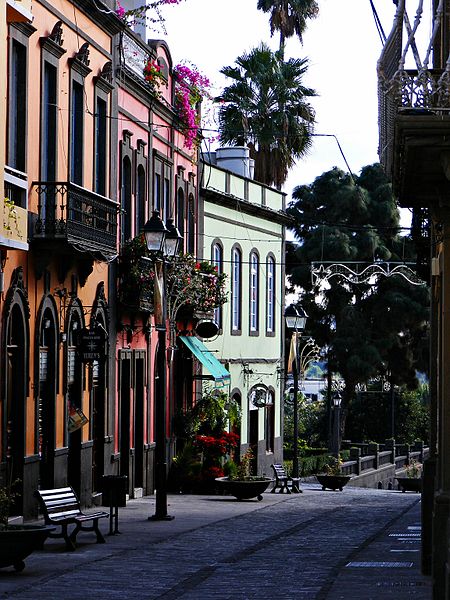
The Puebla Canario is a traditional living village within the Parque Doramas, and one of the main attractions of the city. Enjoy the Canarian architecture, performances in the main square, the Museo Néstor, which features works of the artis Néstor Martín-Fernández de la Torre and Canarian food and wine at this colorful and fascinating showcase of local culture and traditions.
The southern coast offers the beaches and dunes of the Playa del Inglés and the town of Maspalomas with its 19th century lighthouse, lagoon and palm groves. The popular Playa Puerto Rico has bars and restaurants steps away from its fantastic beach with golden sand imported from the Sahara desert and is said to be the sunniest spot on the island.
Mogán, in the southwest, is the second largest municipality. The principal town lies inland, but Puerto de Mogán, known as ‘Little Venice’ because of its canals, is an attractive old fishing village and popular scuba destination.
Going north, one finds Palmitos Park, a botanical garden, aviary and zoo. Plants and animals from five continents and camel rides make this a popular place.
Other towns and sights include the whitewashed houses and jagged cliffs of the town of Agaete, a beautiful fishing village on the northwest coast, the historic town of Agüimes and the nearby cave paintings at Morro del Cuervo, the beautiful mountainside town of Arucas in the north, the Tejeda crater, the largest volcanic basin on the island, popular for hiking and its rugged scenery as well as one of the most beautiful villages in Spain, and Valsequillo on the east coast with its green, imposing rock formations, forests and almond groves.
This list is by no means complete. There is such an array of things to see and do. It is not surprising that it is known as ‘The Little Continent’.
Fuerteventura

Geographically the oldest of the Canaries, Fuerteventura, which means ‘strong winds’, is an island of magnificent beaches, dramatic coastlines and historic villages. It is also the location of the largest desert in all of Europe. Being the closest of the Canaries to the African coast, there is a strong African influence although most would agree that it is very Spanish in spirit.
The villages of Betancuria and La Oliva are worth visiting for their history and charm. Quaint Betancuria is the oldest village of the Canaries. Its cathedral was built in 1410, but was destroyed by invaders and subsequently rebuilt in 1691. To learn more about its history, visit the church museum. La Oliva, in the northern part of the island also has a beautiful old church with a steeple that can be seen from miles around. Inside is a a painting of the Last Judgement which is well worth viewing. The Casa de los Coroneles, is the former mansion of the island Colonel, whose seat was in La Oliva. Don’t miss the pretty stone windmill near the beach!
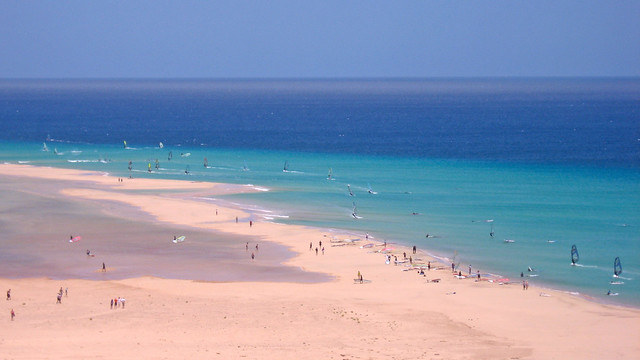
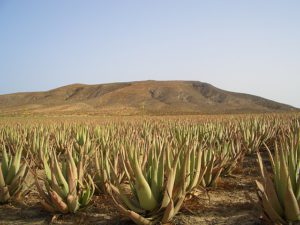
Described as “amazing” and “breathtaking”, the Playa del Cofete with its 7.5 miles of white sand is arguably the most famous beach in the Canary Islands. The half moon shaped Playa de La Concha El Cotillo is reputed to be a great beach for sunsets. The beaches at Corralejo, the main tourist hub and Sotavento are reputed to be the best for surfing and windsurfing. The Corralejo Natural Reserve has the largest dunes in the Canary Islands and is the largest desert in Europe. The dunes are best explore by dune buggy or by camel.
For fishing, hiking and soaking up the sun, the Isla de Lobos, accessible by daily ferry from Corralejo can’t be beat. The small island has been uninhabited since the lighthouse keeper and his family left in the 1960s.
Other attractions include the Oasis Wildlife Fuerteventura, which has lemurs, sea lions, and about 3000 other animals, the largest cactus garden in Europe, and, of course, camel rides. At the Museo de la Sal, the Salt Museum, you can watch how a salt mine works as you tour both the museum and the actual salt mine. Visit the Antigua Windmill Craft Centre to experience a working windmill, or head to Finca Canarias Aloe Vera to visit an aloe vera plantation.
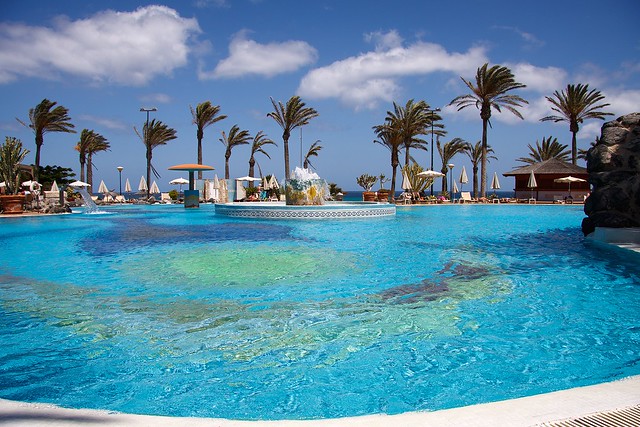
Lanzarote
Lanzarote is truly one of the most unique places on the planet. The lunar like landscape formed by volcanic activity is filled with unusual and unexpected sights. Also known for its white sand and black sand beaches, excellent scuba diving, shipwrecks, and even vineyards, it is no surprise that this island is a very popular travel destination.
Timanfaya National Park tops the list. Its landscape is a result of volcanic eruptions in the 18th century. The park’s ‘Fire Mountains’ resemble the surface of the moon. There is also a restaurant called El Diablo in the park which sells food cooked on volcanically heated grills. El Diablo also has excellent panoramic views of the area.


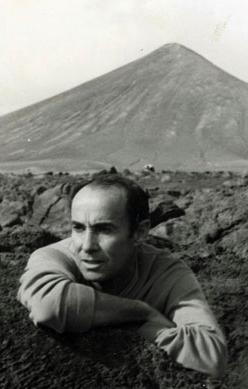
Cueva de los Verdes is another unique volcanic site. Cooling lava created four miles of lava tubes or caves. Visitors can explore approximately one mile of the Cueva, which was used by Canarians as a hiding place from pirates. The effective lighting emphasizes the incredible shapes and colors of the cave, promising a memorable experience. The Volcán El Cuervo is one of many volcanoes on the island, but allows hikers access into the volcano’s crater. Don’t miss the Green Lagoon at El Golfo, a pool of luminous green water created by microorganisms, sea water and sulfur. The bright green is highlighted against the black volcanic landscape, resulting in a very unusual sight.
The artist and architect Cesár Manrique is the creator of Jameos del Agua, a complex which includes a museum, auditorium, café, underground cave bar, gardens and a series of lava caves with a subterranean natural lake inhabited by albino crabs and other creatures. It is a remarkable example of Manrique’s concept of mature and artistic creation in harmony. He also designed the Cactus Garden in the north of the island.
The port city of Arrecife has been the island’s capital since 1852. Visit the Museum of Contemporary Art, located in an 18th century fortress as well as the ‘Venice of the Atlantic’ the area near the marina where one can find a pedestrian area with restaurants, bars and a crowded Saturday market.

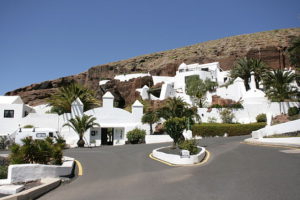
Teguise, which was the capital until 1852 is another popular town on the east side of the island. The Lagomar Museum was guilt around a cliff and is another structure designed by Cesár Manrique, along with Jesús Soto. The museum’s unusual design fetures tube-like halls and cave-like rooms.
Yaiza Village, which lies in the southwest part of the island, survived the 18th century volcanic eruptions. There is a pretty town square, church, gardens and several boutiques and tapas cafés. On the southeast coast, one finds Puerto del Carmen, a resort town which is home to the Rancho Texas Park. The animal/water park has pools and water slides as well as exotic animals such as rare white tigers and komodo dragons.
The beautiful beaches of Lanzarote include the Playa de Papagayo, whose crystal blue waters are perfect for snorkeling. Black lava rocks separate stretches of fine white sand. The picturesque white sand beach Playa Blanca and the black sand beach at Playa Quemada, are two more popular options out of many. And if the countless wonders of Lanzarote turn out to be not enough, why not visit La Graciosa, which was recently granted the legal status of ‘8th Canary Island’ by the Spanish Senate. This small island off the north coast of Lanzarote can be reached in 15 minutes by ferry. It is another island said to have inspired Robert Louis Stevenson’s Treasure Island and it is claimed that there is still gold buried somewhere on the island. There are no paved roads on this volcanic island with a population of about 700, but there beautiful beaches such as the Playa de las Conchas and the Playa de la Cocina, as well as great diving, hiking, two settlements and some great fish restaurants.
The Province of Santa Cruz de Tenerife
Tenerife
The largest island of the Canaries is Tenerife. It is also the most populated of not only the Canaries, but of Spain in its entirety. The island draws somewhere near 5 million tourists annually, perhaps lured by ideal weather year round, which has earned it the nickname ‘Island of Eternal Spring’.

Santa Cruz de Tenerife is the capital city of the province which shares its name. It is the location of the second largest Carnival in the world after Rio de Janeiro. The celebration, whose theme and official posters are chosen by popular vote, takes place in February/March. This year’s theme was ‘The Deep Sea’.
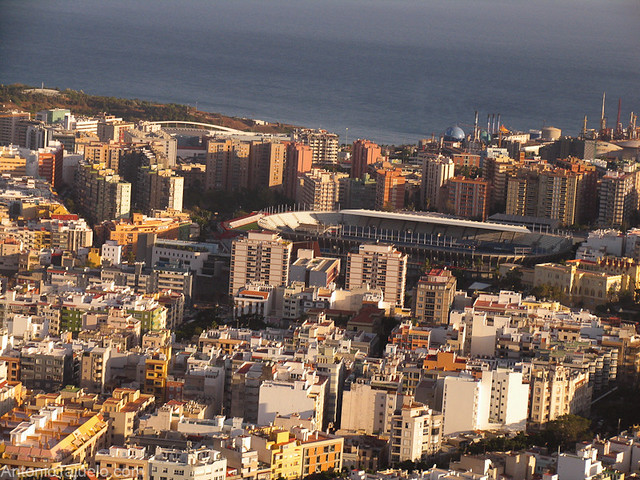

Santa Cruz is best enjoyed by simply wandering through the city. There are numerous parks and squares and great places for shopping. The colonial style municipal market, open daily, offers two floors of boutiques, food shops and cafés. On Sundays there is also a large street market.
The Auditorio de Tenerife, whose avant-guard architecture invites comparison to Sydney, Australia’s opera house, is one of the city’s highlights. Performances include opera, dance, jazz and pop concerts. It is also possible to take a one hour tour of this remarkable facility.
The Palmetum is a botanical garden transformed from a rubbish dump, which features palm trees from around the world. Visitors will find a peaceful place to relax and enjoy nature as well as fantastic ocean views.
The town of La Orotava in the north dates back to 1502 and is the highest and steepest town in Spain. Located within view of El Teide, Spain’s highest mountain, the town is distinguished by its baroque church, scenic plazas and colorful gardens. The village of Masca, originally a Guanche settlement, is perched even higher than La Orotava. With a population of only 100, this village of stone houses is considered by some to be the prettiest village on the island. The hike from Masca to the sea is highly recommended and takes about 3 hours. Garachico is another colorful town on the north coast. Founded in 1496, this port town was partially destroyed by a volcano eruption in 1706. Its attractions include castle ruins, natural pools, scenic plazas and plenty of small seafood restaurants. San Cristóbal de la Laguna’s historic center is a designated UNESCO World Heritage Site. The 16-18th century colonial architecture, cathedral, and popular Museum of Science and the Cosmos draw many admiring tourists each year.

Mount Teide is Spain’s highest mountain. It is also the location of the world’s largest solar observatory. Visitors to Teide National Park can either hike or take the cable car to the base of the cone, where they will be rewarded by views of Tenerife, Gran Canaria and La Palma. There are also tours of the observatory and the possibility of guided tours to the top of the crater.
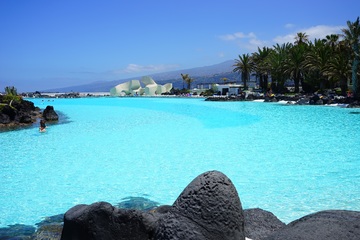
Tenerife’s popularity has resulted in a proliferation of resorts, hotels and theme parks. One of the most popular parks is Siam Park, a Thai themed water park with slides, rides, a floating market and Thai inspired architecture and restaurants. It is located at the Costa Adeje on the south coast, where you can find numerous resorts, restaurants and superb beaches. Aqualand is another popular water park on the Costa Adeje. Further to the north is the Loro Parque Zoo at Puerto de la Cruz. Originally dedicated to parrots, it now has all kinds of animals and an aquarium. It is possible to get a joint ticket for Loro and Siam Parks.
Tenerife’s beaches are nothing short of spectacular. There are many beautiful white, gold and black sand beaches. One of the most popular and convenient, located near Santa Cruz, is the Playa de las Teresitas. The sand on this beautiful man-made beach was brought in from the Sahara Desert. El Medano, on the south coast, is windy and ideal for surfers. The southwest coast of the island is an excellent spot for observing various species of both whales and dolphin. There are various companies that offer boat tours departing from Puerto Colon in Costa Adeje.
La Gomera
A hiker’s paradise, La Gomera is the least commercial and most untouched of the Canary Islands. Its rugged terrain and wide ravines caused the development of a unique whistling language called Silbo, which made communication possible between people separated by the many gorges and ravines on the island. Silbo is still used today and taught in schools. La Gomera is also known for its black sand beaches and excellent wines.
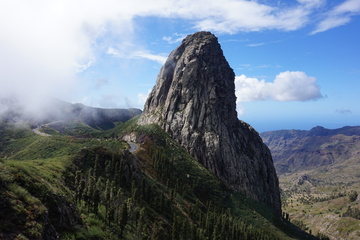
Garajonay National Park covers a third of the island. Its misty, ancient, subtropical forest evokes an other-wordly experience. The park is named after Gara and Jonay, who are the Canarian version of Romeo and Juliet. There are plenty of trails to wander and a visitor center. A popular sight in the park is the Roque de Agando, a towering rock formation which is 1250 meters, or nearly four fifths of a mile high. The many streams and springs and nearly 2,000 species of flora and fauna guarantee an unforgettable experience. The second largest park is the Parque Natural Majona on the east coast. It is one of the wildest areas, with many deep ravines and beautiful vistas. Los Organos, on the north coast, is an unusual organ pipe shaped rock formation that can only be seen by boat.
San Sebastian is the capital city of the island. It is a relaxed sort of place with plenty of restaurants and shopping. Visit the Casa Colon to see the customs house where Christopher Columbus stopped on his voyage to the Americas.
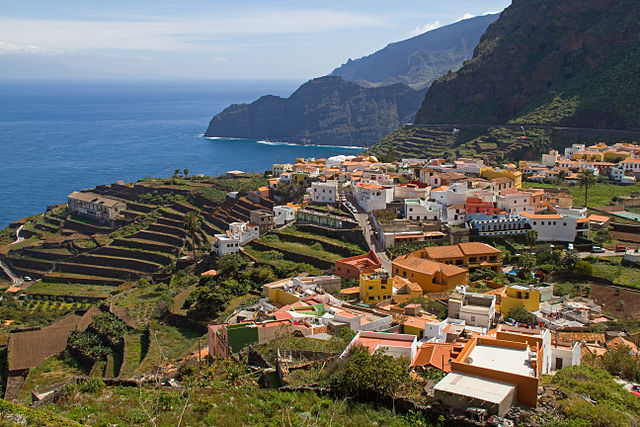
The prettiest village on the island is probably Agulo, on the north coast. For a panoramic view of this colorful village, visit the Mirador de Abrante restaurant which has a seven meter glass floored skywalk from which you can enjoy views of Agulo below as well as Tenerife’s El Teide in the distance.
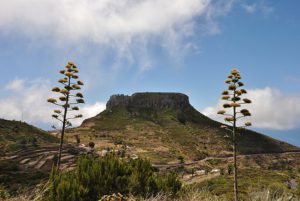
Other towns include Chipude village, a pretty, quiet town near the majestic table mountain, La Fortaleza de Chipude. This oldest settlement on the island has an annual procession and fiesta on the 15th of August. Hikers visit Chipude to make the three hour climb to the top of the town’s landmark and sacred site. Atop the Fortaleza de Chipude one finds not only magnificent views, but also stone circles and sacrificial altars erected by the early inhabitants. Playa de Santiago, a village in the south, appealing for its clifftop views, beach and seafood seafood restaurants. The black sand beach at Valle Gran Rey on the west side of the island is known as the place for sunsets. The town, with its parks, gardens, bars and cafés, is one of the most popular spots on the island.
El Hierro
The smallest of the Canary Islands is El Hierro. Although home to only around 10,000 residents and not as many beaches as one would find on the other islands, El Hierro does not come up short in terms of things to do. Visitors are rewarded with nature, forests, hiking, quiet towns, several natural pools and interesting historical sites.

The Canary Islands’ only capital city not located on a coastline is Valverde, located in the north east part of the island. Although the city dates back to the end of the 15th century, much of the architecture was lost to a major fire in 1899. Two significant landmarks are the 18th century church of Santa Maria de la Concepción and the town hall. Nearby Tamaduste is a town in a remarkably beautiful setting.
Off the western coast of the island there is a volcano emerging from the ocean near the village of La Restinga. In 2011, volcanic eruptions caused the evacuation of residents. The Volcanology Centre at La Restinga features interactive exhibits relating to the eruptions and the geological and volcanic characteristics of the area. The area is also designated as a marine reserve.
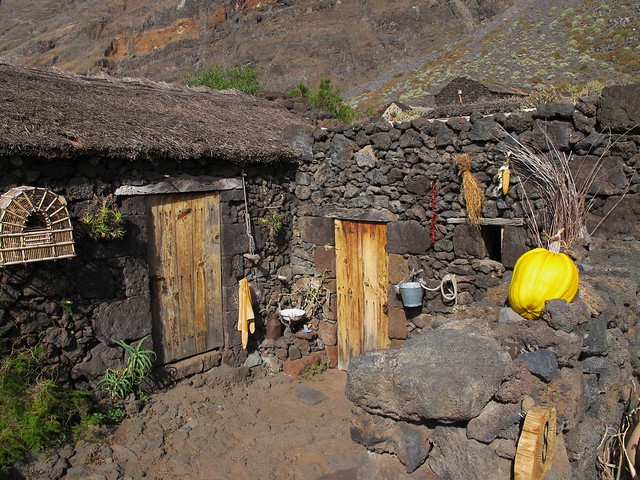
Other fascinating attractions of El Hierro include the Ecomuseo de Guinea, where you will find a volcanic cave and 20 ancient houses portraying island life, the giant lizard sanctuary next door, where you can see the half meter long native giant lizards, the Parque Cultural de El Julán which exhibits petroglyphs from the native Bimbache people and which has incredible coastal views and the Garoé Tree, a sacred tree in Canarian mythology said to have supplied water which sustained the lives of the early inhabitants and their livestock. The location of the Orchilla Lighthouse on the west coast was considered to be the western most point of Europe and was known as the end of the world until 1492. Additionally, it marked the zero meridian on world maps during the 16th and 17th centuries.
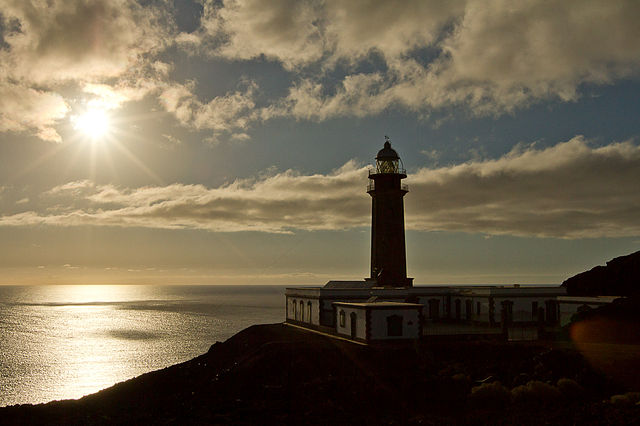
Pozo de las Calcosas is a pretty fishing village in the north with thatched roof houses built out of volcanic rock. Located near Valverde, the village is only reachable by foot. It is also the location two natural pools, protected from the waves of the ocean. The Charco Azul natural pools, located in El Golfo are among the most inviting bathing spots in the Canaries. The pools are free, accessible by stairs and have a bar-restaurant for when you get hungry.
Hiking the trails through the pine forests of La Frontera and El Pinar is another popular activity on the island. A pretty beach, although with not much sand is the Playa de Tacorón in the south.
La Palma
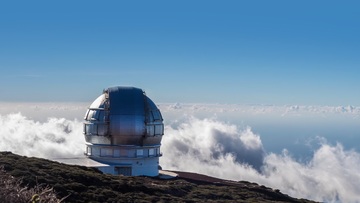
Less touristy than most of the other islands, La Palma is nevertheless not at all lacking in amazing things to do and see. Nicknamed ‘The Beautiful Island’, the entire island is a designated UNESCO biosphere reserve. The whole island is cone shaped, like a large volcano and is very green. Some have claimed that it is the world’s steepest island. Whether that is actually true or not, the landscape of volcanoes, forests and black sand beaches is one of dramatic beauty.
La Palma is a top destination for stargazing and astronomy. Having fewer tourists and a somewhat small population results in one of the world’s best night skies. The astronomical observatory at Roque de los Muchachos is the largest in the northern hemisphere. Stargazing tours are also available.
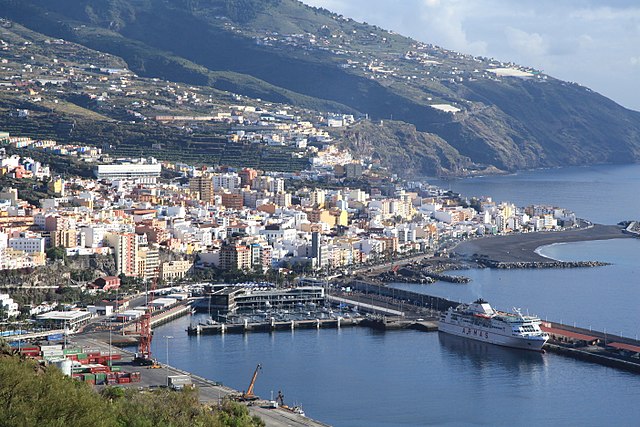
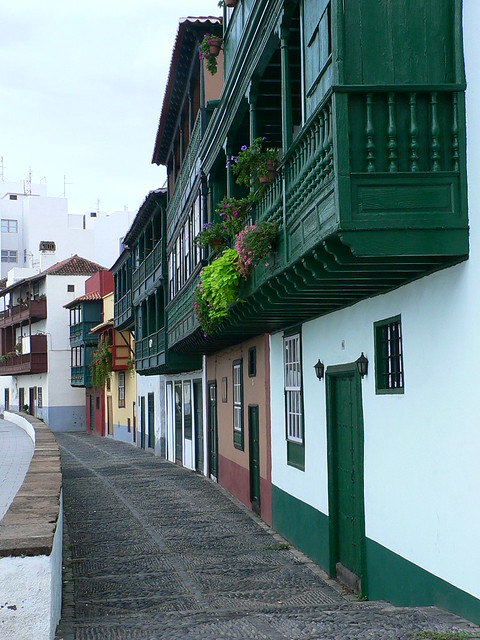
The beautiful capital of La Palma is Santa Cruz de la Palma. With the most unspoiled seafront in the Canary Islands, 15th century architecture, cobblestone streets and attractive wooden balconies, it is one of the most enticing towns in the Canaries. Attractions include the naval museum, which is a replica of the Santa Maria, the ship Columbus sailed to America in 1492. The city offers a large stretch of black sand beach, the beautiful Iglesia Matriz de El Salvador church and the Maroparque Zoo, among other attractions.
The Caldera de Taburiente National Park is comprised of a huge crater covered in pine forest. There are waterfalls, and hiking trails in addition to the Roque de los Muchachos observatory. Among the many hiking trails of the island, the volcanic route hike in Cumbre Vieja Natural Park, is one of the best. Also interesting to visit are the salt pans in the south of the island.
The beaches of La Palma include the black sand beach of Tazacorte in the western part of the island which has conveniences such as cafés and shops. The longest sand beach on the island is the Puerto Naos beach in the southwest, whose black sand has a touch of green to it caused by olivine crystals. Paragliding and night-time scuba diving are available activities and a path shaded with palms leads to several restaurants and terraces. There are also natural rock pools on the western side of the island and the popular Charco Azul in the north.
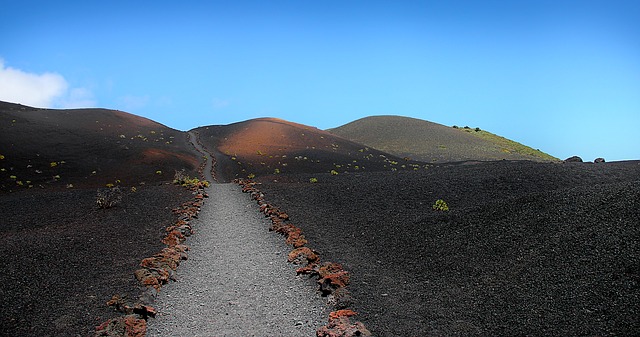
This brings us to the end of my longest post so far! It seems as if the Canaries have an endless array of sights and activities for visitors of all ages and types.
2 thoughts on “Two Provinces, Eight Islands and an Endless Array of Sights and Activities-What to See and Do in the Canary Islands”
Hello John!
What an amazing topic you have choosen for your article. These are so beautiful to visit. And you have shown the amazing ones. Amazed to know about the Canary iseland. And so surprised tonknow thaylt 10 million tourists come to the islands for the perfect vacation weather!!! How amazing. I liked the La Palma most as it looks so beautiful over the cloud. I am dreaming to pay a visit to there. However, thanks for sharing such an amazing article. Hope to see more from you like this.
Thank you for visiting my site and commenting on my Canary Islands post. I’m glad it inspired you to want to go there! La Palma is definitely beautiful and less overrun by tourists, so definitely a great choice!